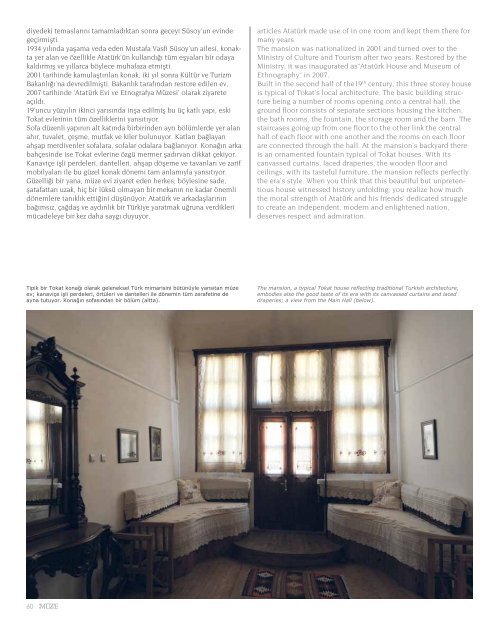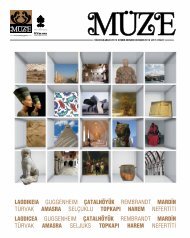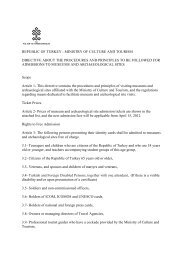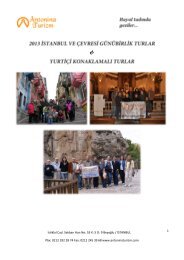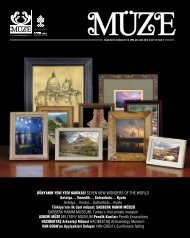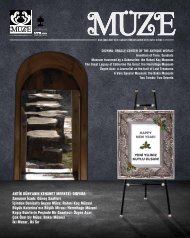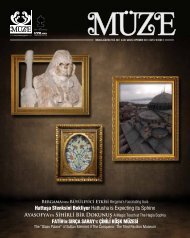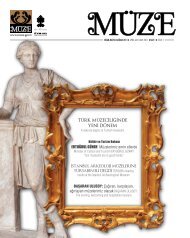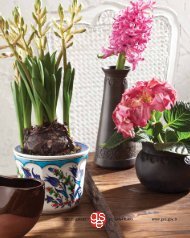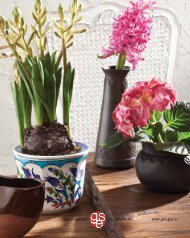GAZİANTEP ZEUGMA MOZAİK MÜZESİ
GAZİANTEP ZEUGMA MOZAİK MÜZESİ
GAZİANTEP ZEUGMA MOZAİK MÜZESİ
You also want an ePaper? Increase the reach of your titles
YUMPU automatically turns print PDFs into web optimized ePapers that Google loves.
diyedeki temaslarını tamamladıktan sonra geceyi Süsoy’un evinde<br />
geçirmişti.<br />
1934 yılında yaşama veda eden Mustafa Vasfi Süsoy’un ailesi, konakta<br />
yer alan ve özellikle Atatürk’ün kullandığı tüm eşyaları bir odaya<br />
kaldırmış ve yıllarca böylece muhafaza etmişti.<br />
2001 tarihinde kamulaştırılan konak, iki yıl sonra Kültür ve Turizm<br />
Bakanlığı’na devredilmişti. Bakanlık tarafından restore edilen ev,<br />
2007 tarihinde ‘Atatürk Evi ve Etnografya Müzesi’ olarak ziyarete<br />
açıldı.<br />
19’uncu yüzyılın ikinci yarısında inşa edilmiş bu üç katlı yapı, eski<br />
Tokat evlerinin tüm özelliklerini yansıtıyor.<br />
Sofa düzenli yapının alt katında birbirinden ayrı bölümlerde yer alan<br />
ahır, tuvalet, çeşme, mutfak ve kiler bulunuyor. Katları bağlayan<br />
ahşap merdivenler sofalara, sofalar odalara bağlanıyor. Konağın arka<br />
bahçesinde ise Tokat evlerine özgü mermer şadırvan dikkat çekiyor.<br />
Kanaviçe işli perdeleri, dantelleri, ahşap döşeme ve tavanları ve zarif<br />
mobilyaları ile bu güzel konak dönemi tam anlamıyla yansıtıyor.<br />
Güzelliği bir yana, müze evi ziyaret eden herkes; böylesine sade,<br />
şatafattan uzak, hiç bir lüksü olmayan bir mekanın ne kadar önemli<br />
dönemlere tanıklık ettiğini düşünüyor; Atatürk ve arkadaşlarının<br />
bağımsız, çağdaş ve aydınlık bir Türkiye yaratmak uğruna verdikleri<br />
mücadeleye bir kez daha saygı duyuyor.<br />
Tipik bir Tokat konağı olarak geleneksel Türk mimarisini bütünüyle yansıtan müze<br />
ev; kanaviçe işli perdeleri, örtüleri ve dantelleri ile dönemin tüm zerafetine de<br />
ayna tutuyor. Konağın sofasından bir bölüm (altta).<br />
60<br />
articles Atatürk made use of in one room and kept them there for<br />
many years.<br />
The mansion was nationalized in 2001 and turned over to the<br />
Ministry of Culture and Tourism after two years. Restored by the<br />
Ministry, it was inaugurated as“Atatürk House and Museum of<br />
Ethnography” in 2007.<br />
Built in the second half of the19 th century, this three storey house<br />
is typical of Tokat’s local architecture. The basic building structure<br />
being a number of rooms opening onto a central hall, the<br />
ground floor consists of separate sections housing the kitchen,<br />
the bath rooms, the fountain, the storage room and the barn. The<br />
staircases going up from one floor to the other link the central<br />
hall of each floor with one another and the rooms on each floor<br />
are connected through the hall. At the mansion’s backyard there<br />
is an ornamented fountain typical of Tokat houses. With its<br />
canvassed curtains, laced draperies, the wooden floor and<br />
ceilings, with its tasteful furniture, the mansion reflects perfectly<br />
the era’s style. When you think that this beautiful but unpretentious<br />
house witnessed history unfolding; you realize how much<br />
the moral strength of Atatürk and his friends’ dedicated struggle<br />
to create an independent, modern and enlightened nation,<br />
deserves respect and admiration.<br />
The mansion, a typical Tokat house reflecting traditional Turkish architecture,<br />
embodies also the good taste of its era with its canvassed curtains and laced<br />
draperies; a view from the Main Hall (below).


